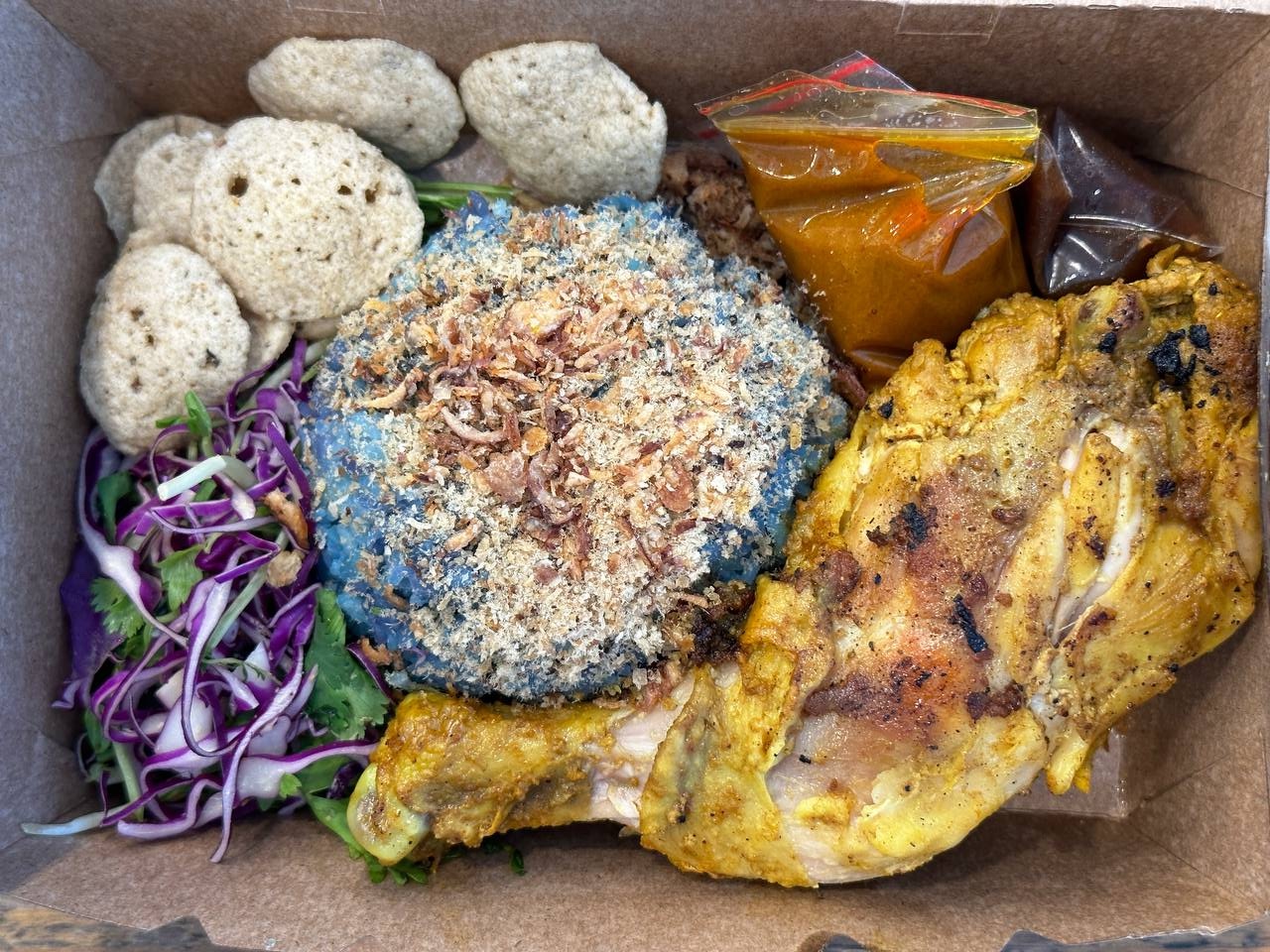Ramadan bazaar vendor who says he broke even by 2nd day shares why he prefers setting up shop in the heartlands


 PUBLISHED ONMarch 28, 2024 5:10 AMByMelissa Teo
PUBLISHED ONMarch 28, 2024 5:10 AMByMelissa Teo We have heard, more than once over the years, of bazaar vendors struggling to stay afloat due to high costs.
And then we have Muhammad Hafiz bin Abdul Rahman, who shares with AsiaOne that his stalls at Admiralty and Tampines have all broken even in less than a week. Another booth at Bedok is provided rent-free, thanks to a business partner.
The 40-year-old is currently managing two businesses — Krunchy Fritters, selling fried banana fritters, and Kerabu, which specialises in a dish called nasi kerabu.
When AsiaOne visited Hafiz at the bazaar outside Admiralty MRT station on March 18, he shared that Kerabu, which was established in November last year, is a collaboration between him and two partners — Salai by Meatdrop, and Malaysian actor and host, Shuk Sahar. Krunchy Fritters is his own business.
The folks behind Halal hawker chain Salai by Meatdrop were the ones who invited Hafiz to join them on this "new project". And that was how he discovered what nasi kerabu is.
For the uninitiated, it's a Malaysian rice dish that features blue-coloured rice and an assortment of ingredients such as dried chicken, crackers, pickles and sambal.
Hafiz and his team mostly run the operations at Kerabu's Admiralty booth, while Shuk Sahar, the face of the brand, is stationed at the Bedok stall.
On the other hand, the team at Salai by Meatdrop mans the kitchens and ensures that quality boxes of nasi kerabu are pushed out daily.
It's actually Kerabu's first time participating in a Ramadan bazaar and last November, when they first launched the brand, they ran four booths at another event.
This time around with one less booth than before, all three have already recouped their initial investment within a week of opening, Hafiz shared.
He added that the Admiralty booth, which opened on March 6, saw the nasi kerabu selling out in under 1.5 hours on weekends.

The Tampines booth which opened on March 12, on the other hand, broke even within the first two days of opening, Hafiz said.
"On the first or second day of Raya, we brought around 100 boxes of nasi kerabu to our Tampines stall. Within 15 minutes, it was finished," he recounted.
"People complained because they had travelled so far to buy our food and it was all gone."
While Kerabu has already made a name for itself in such a short span of time, Hafiz and his partners avoided setting up shop at the more hyped-up Ramadan bazaars at Geylang Serai and Kampong Gelam.
But why?
Just last year, Hafiz himself had a booth at Geylang Serai Ramadan Bazaar for Krunchy Fritters.
While he thankfully managed to break even and make a small profit, he experienced first-hand how hefty the investment can be.
"I try to avoid Geylang because of the costing," admitted Hafiz.
Back then, just the stall rental alone was $11,000, not including additional components such as the sink, power points and electricity.
It took Hafiz two weeks just to break even.
"It was very pressurising," he confessed to us, sharing that his space wasn't even considered that expensive and he had heard of other vendors who forked out even more per booth.
He felt that the high rental cost and amount of effort required to try and recoup his investment were not worth it.
"Yeah, I had fun. There were some Hari Raya vibes. But I won't do it unless I have a new hipster product," he concluded.
This year, his booths at Admiralty and Tampines cost $8,000 and $2,000 respectively.
The cost of the Admiralty booth is shared between Kerabu and Krunchy Fritters, while the Tampines and Bedok booths are purely for Kerabu.

The Bedok unit is loaned to Kerabu for free, thanks to the presence of Shuk Sahar.
Hafiz told us that the he has set himself a budget of $12,000 for the rental of stall spaces.
"Even $12,000 is heart pain," he told us frankly.
Hafiz also much prefers the energy at heartland areas like Admiralty and Bedok.
"I like the crowd here because there are a lot of families. They're also willing to spend more," he shared, adding that lower rental helps him keep his food prices more affordable.
However, it doesn't mean that the more popular bazaars are not great places to have stalls at — it's all up to personal preference.
Hafiz told us that some people prefer having booths at Geylang Serai because of the longer hours.
"They can operate till 1am or 2am. For the Admiralty bazaar, business slows down around 9.30pm to 10pm," he explained.
The crowds there tend to be bigger too.
Hafiz believed that the younger generation tend to hang out more at these mainstream bazaars.
So if that's your target audience, Geylang Serai Ramadan Bazaar and Kampong Gelam would be more viable locations.
Either way, Hafiz feels that running an F&B stall during the Ramadan period is always a good idea.
"You can meet new friends and catch up with all your customers. This is the only time you will get to see so many people," he shared.
"Compared to some of the pasar malam I'd joined previously, the vibe isn't the same. And the sales during Ramadan are much better as compared to other months."
ALSO READ: F&B stalls to offer $3 items at this year's Geylang Serai Ramadan Bazaar
melissateo@asiaone.com